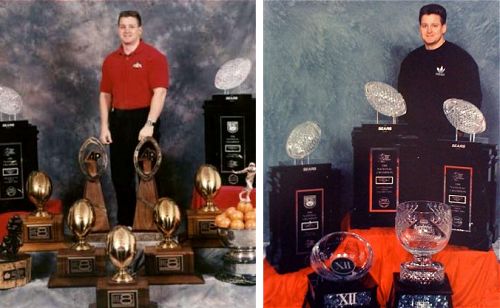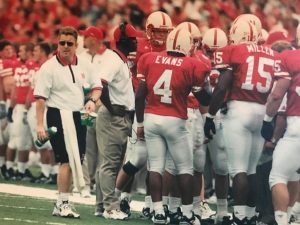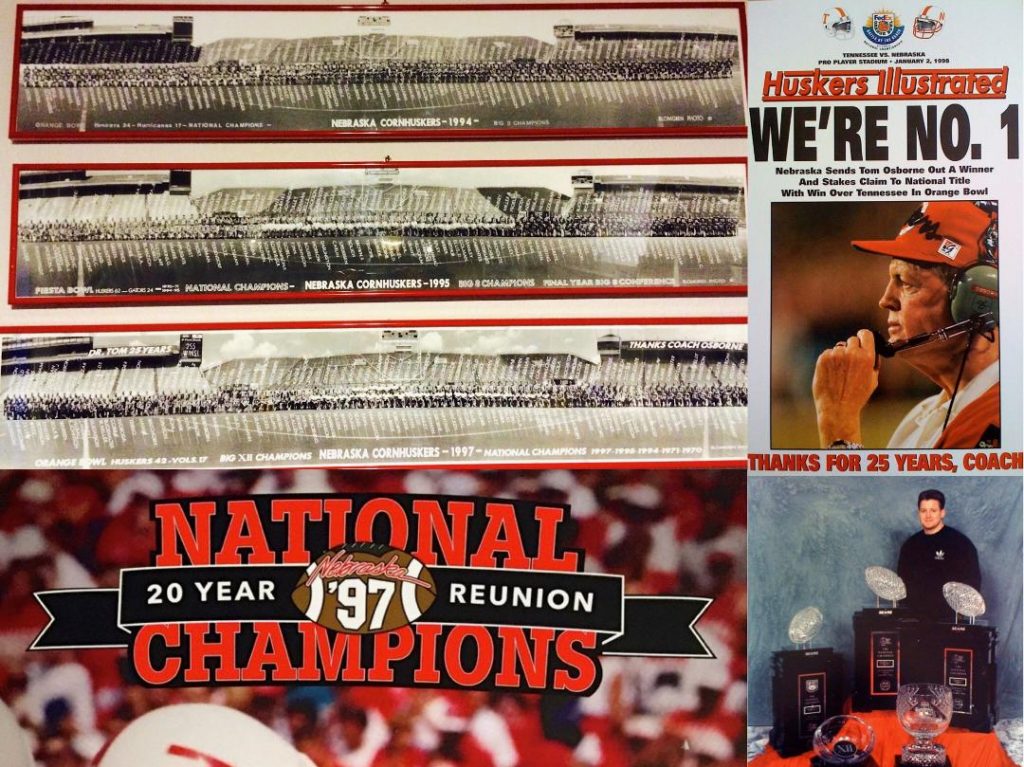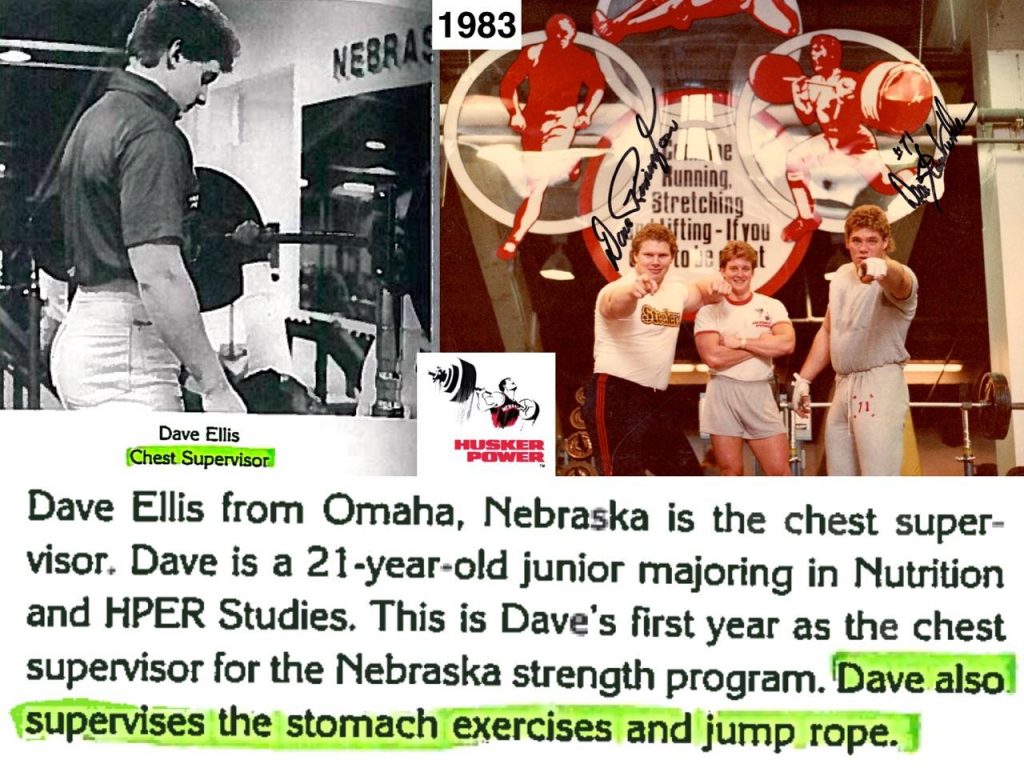Anatomy of an Era: Dave Ellis, Part 4

Excerpted from Chapter 9, No Place Like Nebraska: Anatomy of an Era, Vol. 1
Dave Ellis, Part 4
Sports Nutritionist #fuelingtactics
Q: Any final thoughts on those championship Husker years? Anything behind the scenes you thought made a difference?
DE: Well, you know, Steve Pederson, I’ll give him some props. I know he didn’t go out on a great note with the fans of Nebraska. They would have probably preferred to see Tom as the A.D. on the first go around, but Steve was really strong at taking care of off-the-field football business as a Football Operations guy back in his day, and he and Boyd were juggernauts when it came to recruiting. So if the coaches could just tell them who to get in there for a visit, they would make sure from the time that visit started until the time it ended that it was a really well-oiled machine and the kid got some exposure and the kid would really remember it after all of those visits, “Man, Nebraska really had their act together.”
And time and time again, nutrition was the differentiating factor. The fact that we even had a system, a training table, even had a supplement program, that we even tried body composition assessment, that we even knew what frame assessment was in predicting weight gain, all these things were differentiating factors. So our off-field organization, with Steve and Boyd as far as the recruiting piece, was great. And the innovation Psychologist Jack Stark brought to the table was great. Tom once said, “Nutrition could make a 2, 3, even 4% difference in the highest levels of sport. Even a half percent will make a difference.” We were just part of a pretty well-oiled machine.

Q: You mentioned ‘frame assessment.’ I remember you getting into that. What does that entail, for the average fan’s curiosity?
DE: It deals with lot of measurements of skeletal structure beyond height that have big impacts on somebody’s individual capacity to carry body mass in the form of muscle. For example, a Chris Dishman -not the tallest cat in the world- but he had the trunk of somebody who is seven foot-two, you know? Short legs, but this mass of humanity and this very long trunk. If someone has a long trunk relative to their height they carry more weight, so ‘wide shoulders, deep chest, wide hips, deep pelvis,’ they have a very robust frame, like you find on the big Czechs, Polacks, and Dutch–types you find there in the upper-Midwest.
I used to measure athletes all over the country, now -literally- so it’s kind of interesting. Starting in the Dakotas and all the way into upstate New York there are some huge human beings. There are some big Clydesdales and they are… they’re getting bigger. It’s not uncommon to run into the 350-400 pounders now who are 24-25% body fat or less. That’s the typical body fat of a lineman who can move. In my lifetime kids have gotten bigger, and a way to determine who can carry more weight for their height is based on trunk length and the more robust characteristics of their frame. It’s something I almost published for a thesis, actually, but I ended up not doing it because so many teams pay me to come in and do that. It may be the only thing I do for some teams, monitor body composition and frame. It’s a differentiating factor for my private practice and it’s totally proprietary, I don’t give the formula away.
Bo Pelini brought me back in to come and measure frames up for him. I got to know Bo when he was at Oklahoma, actually. And so that helped their staff, who didn’t know that group of athletes, to be able to look at them and say, “Defensive end or defensive lineman? Tight end or guard?” Help them know what’s going on…
Q: So you’re helping find the correct placement on the field for these guys as far as position & body type?
DE: I do that a lot now. I turn around and tell a team when they’ve got a player who can’t get any bigger, who’s really stacked for their frame or who has room for additional mass, I can think of them playing in a couple different spots. I’ve got a formula depending on what your needs are: you can keep them light and mobile or could accrue more mass and play in a smaller space where more body mass is required. So yeah, I do a lot of helping any sport figure out what is appropriate on an individual basis in sorting out what spot they play in that sport. You’ve got all kinds of little fullback types and noseguard types and sawed-off guards and center-types that carry a ton of weight for guys of a very short stature. So it’s a big part of my practice. It’s what brings me back in for these teams.
Major League Baseball and NBA? A lot of young kids, these cats aren’t done growing, so we can see even when the vertical growth slows, Paul. A late-bloomer may not be done growing until his sophomore or junior year of college, but once they are done growing vertically they still stretch out: their shoulders get wider, their chest gets deeper, their hip and pelvis gets wider ’til their mid- to late-20’s. So we’re monitoring frames to see when they quiet down, when the vertical piece is over, when the dimensional changes are over, that’s who they are. Then their frames stay quiet… and then they start shrinking! At about age 35 they start losing bone mass. You know, bone is just like muscle: frames actually start getting smaller. It’s in a constant state of flux. It’s just a little harder to see the changes because they happen in smaller increments.
Q: You’re a pioneer, Dave. You are the very first human being I ever saw wearing Rollerbades. In what, ’87? You used to rollerblade around the football field’s old track when the band was practicing at about 6 in the morning.
DE: (laughs) Yeah, that’s going way back! Until the bread truck almost took me out one day! Seriously, I hit a few funny spots around that field. It wasn’t the best place to do that. Rollerblades, I might have had one of the first pairs of those. I remember a cop pulling me over in Lincoln once just so he could see what I was doing. I was rollerblading from my house out on about 48th Street down to the University at the crack of dawn and this guy was like, “Buddy, I don’t know what you’re doing, but you need to get out of the street. What the hell have you got on your feet?” Good old Lincoln, Nebraska. (laughs)
But I tell you what, Tom’s and Charlie’s were big sets of shoes to stand in, and there’s not a dollar value you can put on leadership that is time-tested. And those coaches were comfortable in their own skin and they had nothing to prove. They could go out there and emit a totally different kind of persona than a person who’s trying to prove that they can do the job.
But in the end, I do stay in touch with Tom. We do stay in touch. It’s mostly me calling him. But I’ve always tried to communicate with him over the years because he’s a big enough man to stand in there and talk about things to a football team, “Why it’s important to love the guy playing next to you”, and he can come off in a very meaningful and credible fashion. I was in every one of his team meetings his last year when I was there. I tried to make every one the whole time I worked there. I was in every one of them. I didn’t know, I wasn’t sure…‘What if this is Tom’s last year? I’m gonna make every one I can make.’ And it was truly his best year of messaging to the athletes that I had ever seen.

A mosaic of football dominance (Nebr. Sports Info)
Q: In what regard?
DE: You know, just in that he always put thought into what he was gonna say. But I think he went out of his way that last year to try to message to them in a level that maybe any other year he could have said, “Nah, we can make it through this year without a lecture on why it’s important to love your fellow teammate.” Love.. you don’t hear a lot of coaches lecturing about that. ‘Man Love’, you know? That’s what I’m saying. That was just one of the principle-laden lectures where the kids in the room, maybe they didn’t have any clue of the message they were hearing. They showed up like any kid running from class to class, kind of getting ready for football practice. They had no idea the caliber of messaging that was coming from Tom, messaging that most coaches would never attempt.
So that’s my kind of respect for Tom. I’m the kind of guy who defends him over Lawrence Phillips. I say, ‘Tom is the kind of guy who keeps Lawrence close for Lawrence’s benefit, not the program’s benefit. He cares whether the kid is gonna go back to the streets or come back and potentially become a citizen.’ Of course, he got burned on that one, but in the end I know he did it for the right reasons, not the way the media tried to portray it. That’s the kind of guy he is.
He obviously had some juice in him when he got done coaching or he wouldn’t have become a Congressman. My point is: he’s a leader. He can do anything he wants to be a leader in. My respect for him? I can’t really measure. Like the Lute Olsons of the world. I worked for Lute at Arizona. Lute and Tom, in my estimation, are the same kind of cats. Comfortable in their own skin, confident, there’s nothing they haven’t experienced or gone through, and were just as concerned about the development of their athletes as good citizens and potential leaders off the field as they were about the wins on the court or on the field. There are a very select group of people out there, and Tom is in a very elite class, so I just stay in touch with him out of respect for the man.
Q: Any funny stories from back in the day?
DE: Have I ever told you about the great Braunschweiger Barfing Fiasco (BBF)?
It’s a ‘before I left for Wisconsin’ story. And you never know when opportunity will knock, alright? A couple of years before I left Nebraska to work with Alvarez at Wisconsin., maybe ’87 or so.
The old food service manager over at the training table was named Hanna Hess, and she ran the place like it was an old family business. Everything ran through Hanna! (Once I made a suggestion on moving the ketchup dispensers, and then suffered a good reprimand from Hanna to mind my own business at the time I was a strength coach studying nutrition.)
Now, being part of the strength staff, I had a very good feel for how hard the workouts were going to be after lunch… and on one particularly hard sprint day I noticed that Hanna had put out a big German bologna and braunschweiger feed. The players were killing it, too, making these monster-thick sandwiches that had no chance to digest before we ran. Mind you, we were sprinting on an old indoor dirt track under the East Stadium –Mushroom Gardens, we called them- back in those days, which smelled of mold from the leaky stands above and always filled with dust when we got a stampede of athletes sprinting together.
With all that in mind, I cautiously approached Hanna, trying to get her off to the side to warn her about what I felt was an accident waiting to happen, but I only got a few words out before getting a brush-back pitch from Hanna with her thick German accent that went something like… “Never you mind, the boys love this… now on your way.” I’m sure if she would have had a broom handy I would have gotten a swat on the backside to boot! Oh well, it was about time for the team lifting and running to begin…
So imagine that we had the entire team lifting in this big weight room under the West Stadium called the Strength Complex followed by a series of workout stations on the turf in the North Stadium that were a series of agility and power-focused drills, all before we made our way as a team to the mushroom gardens under the East Stadium for the coup de grâce, a series of 110-yard sprints… with all those stomachs full of partially-digested lunch meats and cheeses.
I actually ran the sprints with the athletes back in those days, and as we hit the last straightaway of the last 110 with the coaches standing near the finish line watching, I witnessed something truly unique. It was a long line of athletes leaning against the dust-covered wall simultaneously blowing braunschweiger up! One coach in particular was watching this with a confused look on his face. It was the Head Football Coach Tom Osborne, who came up to me and said, “Why do you think we have so many guys getting sick? I’m not sure I have ever seen anything like this before”… to which I tried to answer -between efforts to catch my breath- that we had a lunch that didn’t quite fit the pre-workout bill today.
Dr. Tom looked at me and asked if I could start to take a look at Hanna’s menus going forward to spot issues like this so they could be avoided, to which I agreed. And that was how I got my first real degree of responsibility at the training table. The great Braunschweiger Barfing Fiasco opened a door for collaboration that had been firmly closed up till that point with Hanna and her staff.
By the time I got back from working at Wisconsin for Alvarez, Hanna had moved on and edits to the menus and merchandising of the food came much easier from that point forward.
Q: Too funny! I’ve heard the one about a certain out-of-condition or hungover lineman barfing and then eating it right away so the coaches wouldn’t see, but never the BBF. (laughs) Well, Buck…. I don’t know if anybody calls you ‘Buck’ anymore…
DE: Yeah, that name really stuck, I tell you. Dave Kennedy gave me that name. I showed up to work one time in an old flatbed International truck that I had. I must have been wearing some junky boots -I must have been working in my yard or something- and he says, “You look like Buck of the Wilderness.” I looked like I’d just come from some hayseed farm. Kennedy still calls me Buck. Guys from that era, that staff, still call me that. The guys I still keep in touch with from those days are the strength coaches from those days. Kennedy’s at A&M, Schmitty’s at Oklahoma. I run into Tony Samuel and Gene Huey now and then at the NFL Combine in Indianapolis, Frank Solich, I used to keep track of Charlie in Arizona. I don’t even know if I have his number anymore, though. You’ve got to talk to Charlie.
And I tell you, Matt Turman, you remember when Tommie and Brook were down? Guess who was out there running that offense down there at Kanasas State?
Q: I wish I could have been to that one, but I was helping some nutritionist’s wife move the family to a different house in Lincoln that day while he was down in Manhattan, Kansas. (laughs)
DE: (laughs ) Well, I saw a few of ’em, and I tell you something. Termie? We were three and out, three and out, three and out, and it was that defense that won that first national championship for us. There were a lot of hard-headed, tough kids on offense and they held their end up at the end, too. There were a lot of games where the offense was a little disabled that year, but there were some badasses on the defense. I tell you what, the Peter brothers? If you went back to Viking days and one of the longboats pulled up on shore and they came out with swords and the freaking horn-helmets, it would have been the two Peter brothers off first. They were like warriors that I’ve never met…and I’ve meet some badasses. These were two of the baddest dudes I’ve ever met. They were, along with Wistrom, the real deal.
Q: Do you think Jersey made them that way or what?
DE: Maybe, yeah. Well, when Alvarez turned his Wisconsin program around, he went to Chicago. There’s some badasses from Chicago, some kids didn’t mind going out in bad weather. Certainly they’d been in a lot of tussles growing up in life, in tough schools, their backs to the wall and being in a bar fight was just a weekly deal for these guys.
They were just tough kids. Pain? No big deal. Broken finger? Tape it, no big deal. Big, bloody, fat lip? No big deal. Warriors, Paulie. Warriors….
End conversation.

Young bucks, circa 1983 (Nebr. Sports Info)
Well, if you at all doubted me earlier, are you now a believer? Maybe you thought that whole ‘Eminence Outlier’ stuff at the beginning was a bunch of new-agey management nomenclature and high-minded, ivory tower hogwash, but a person would be hard pressed to walk away from any encounter with Dave Ellis and not have something to place in your pocket for at least one extra victory per year. He mentioned Coach Osborne’s reference to the 2, 3, or 4% difference proper nutrition and game-time hydration management could make in a season and couldn’t have been more correct.
Look at his later Super Bowl experience and the difference his one defender/client made in securing a victory in the ultimate game. Let’s be honest, network television isn’t too keen on showing players puking on the sideline while trying to sell you potato chips and soft drinks during the commercial breaks, so you’d likely have had no idea what really happens down there on the sidelines without some input from a man who was there, who lived it. And he’s got the rings to show for it, too.
In a word, Dave was invaluable. Plus, he got along fantastically with the student/athletes. And in case you haven’t put two and two together, the season Dave showed up was the season Nebraska earned its first national championship of that era, stated as only Dave could: “..and (Tom) won his first National Championship in a very hostile environment in Miami, an extraordinarily hostile environment, almost unthinkable to go in there and jerk one out of their teeth on their turf in that cesspool. About as hostile a crowd as you’ll ever be around.”
In author Jim Collins’ book, a portion was dedicated the role technology played in those stellar companies’ rise, which, from his perspective didn’t really amount to much. On this point I would differ, because Dave and the whole organization were working with the oldest technology out there: the human body. And through better strength training, better nutrition and better recovery methods, Nebraska Football took the old school technology of the human body and had them all humming like Porsches on the Autobahn with the RPM needle tickling the red.
I’ll mention two other things from the vast multitude of directions one could go with the info garnered from this interview, and they would be his mention of selfishness -or lack thereof- on those teams, as well as the drive and purpose for which the whole organization strove for. There is a term called ‘success disease’ and it’s been known to infect even the best of organizations, resulting in less than best efforts, a decrease in motivation, and a few extra taps on the snooze button instead of ‘up-&-at ’em’ energy to start the training day. (You may have even seen a small outbreak in early 1996 versus Arizona State, but that bug was quickly driven out of the ranks by that loss.) Dave has worked alongside the best of the best in the professional ranks in recent years, and I know he takes profound pride in being around those athletes from the 60 & 3 years. This pride is not only due to the victory tallies, mind you, but for the team’s toughness and indomitable spirit. There were some warriors out there, and they were the terror of their foes. “Warriors, Paulie. Warriors….,” as Buck stated. Match up a group of warriors with a few Eminence Outliers and you’ve got yourself one hell of a force to be reckoned with.
Notable quote #2:
Dave Ellis on team culture: “There’s no ‘chance happening.’ This is why teams succeed: You always have guys who take control in that locker room, and then have a presence on the field or the court that eliminates the most selfish, self-centered, ‘what’s-in-it-for-me’ guys, and makes them champions.”
Copyright @ 2013 Thermopylae Press. All Rights Reserved.
Photo Credits : Unknown Original Sources/Updates Welcomed
Paul Koch